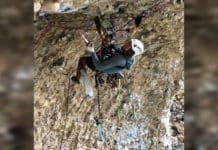
Sept. 26 (UPI) — The MacArthur Foundation handed out 26 so-called genius grants Wednesday to artists, lawyers, scientists and writers from across the country.
They each receive a “no strings attached” five-year grant of $625,000 to continue work in their chosen fields. Started in 1981, the MacArthur fellowship is considered among the most prestigious prizes in the United States.
“From addressing the consequences of climate change to furthering our understanding of human behavior to fusing forms of artistic expression, this year’s 26 extraordinary MacArthur Fellows demonstrate the power of individual creativity to reframe old problems, spur reflection, create new knowledge, and better the world for everyone,” MacArthur Foundation president John Palfrey said. “They give us reason for hope, and they inspire us all to follow our own creative instincts.”
They include the following people, as described by the foundation:
— Elizabeth Anderson, 59, of Ann Arbor, Mich., a philosopher examining how evolving concepts of freedom and equality are experienced in our daily lives.
— Sujatha Baliga, 48, of Oakland, Calif., an attorney and restorative justice practitioner demonstrating the efficacy of survivor-centered restorative justice alternatives to traditional legal interventions as a means of helping crime survivors to heal, holding those who have caused harm accountable, and breaking cycles of recidivism and violence.
— Lynda Barry, 63, of Madison, Wis., an educator, cartoonist, and graphic novelist unleashing the creative powers in others through a teaching practice centered on image making and writing.
— Mel Chin, 67, of Egypt, N.C., a category-defying artist whose practice calls attention to complex social and environmental issues.
— Danielle Citron, 50, of Boston, a legal scholar addressing the scourge of cyber harassment by raising awareness of the toll it takes on victims and proposing reforms to combat the most extreme forms of online abuse.
— Lisa Daugaard, 53, of Seattle, a criminal justice reformer developing an alternative to standard drug law enforcement that improves policing, outcomes for individuals suspected of law violations, and public safety.
— Annie Dorsen, 45, of Brooklyn, N.Y., a theater director and writer producing works that dramatize the complex interface between machines and humans. Dorsen creates what she calls “algorithmic theater,” in which algorithmically determined texts are generated in real time for each performance of a piece.
— Andrea Dutton, 46, of Madison, Wis., a geochemist and paleoclimatologist reconstructing sea levels and ice sheet changes during earlier periods of global warming on Earth.
— Jeffrey Gibson, 47, of Annandale-on-Hudson, N.Y., a multidisciplinary artist and craftsperson merging traditional Native American materials and forms with those of Western contemporary art to create a new hybrid visual vocabulary.
— Mary Halvorson, 38, of New York City, a guitarist, ensemble leader, and composer who is pushing against established musical categories with a singular sound on her instrument and an aesthetic that evolves with each new album and configuration of bandmates.
— Saidiya Hartman, 58, of New York City, a scholar of African American literature and cultural history whose works explore the afterlife of slavery in modern American society and bear witness to lives, traumas, and fleeting moments of beauty that historical archives have omitted or obscured.
— Walter Hood, 61, of Oakland, Calif., a landscape and public artist creating urban spaces that resonate with and enrich the lives of current residents while also honoring communal histories.
— Stacy Jupiter, 43, of Suva, Fiji, a marine scientist integrating local cultural practices with field research to develop conservation solutions that protect both the biodiversity of coastal ecosystems and the well-being of communities dependent on them.
— Zachary Lippman, 41, of Cold Spring Harbor, N.Y., a plant biologist investigating the genetic networks underpinning plant development and growth and creating new breeds of hardier, higher yielding crops.
— Valeria Luiselli, 36, of Annandale-on-Hudson, N.Y., a writer of fiction, essays, and inventive hybrids of the two who challenges conventional notions of authorship and explores the experience of dislocation as a common theme across her many projects.
— Kelly Lytle Hernández, 45, of Los Angeles, a historian challenging long-held beliefs about the origins, ideology, and systemic evolution of America’s modern-day incarceration and immigrant detention practices.
— Sarah Michelson, 55, of New York City, a choreographer expanding the scope of contemporary dance in works that explore the nature of dance itself, both as an art form and as physical, intellectual, and emotional labor.
— Jeffrey Alan Miller, 35, of Montclair, N.J., is a scholar of early modern English literature and theology who is shedding light on the emergence of key ideas about the role of faith in daily life and government among Reformation and Renaissance scholars.
— Jerry X. Mitrovica, 58, of Cambridge, Mass., a geophysicist elucidating the dynamics of Earth’s crust and mantle in response to glacial melting and the resulting implications for sea level rise.
— Emmanuel Pratt, 42, of Chicago, an urban designer creating a model of resident-driven community development in neighborhoods that have suffered the effects of long-term disinvestment.
— Cameron Rowland, 30, of Queens, N.Y., an artist making visible the institutions, systems, and policies that perpetuate systemic racism and economic inequality.
— Vanessa Ruta, 45, of New York City, a neuroscientist tackling one of the fundamental questions of neuroscience: how the brain processes sensory information and generates behavioral responses.
— Joshua Tenenbaum, 47, of Cambridge, Mass., a cognitive scientist working at the intersection of computational cognitive science, developmental psychology, neuroscience, and artificial intelligence to investigate how the mind works.
— Jenny Tung, 37, of Durham, N.C., an evolutionary anthropologist investigating the interplay between social experiences, genomics, and health.
— Ocean Vuong, 30, of Amherst, Mass., a poet and fiction writer whose works explore the ongoing trauma of war and conditions of exile with tragic eloquence and clarity.
— Emily Wilson, 47, of Philadelphia, a classicist and literary scholar demonstrating the vital role translation plays as a creative form of mediation across linguistic borders and between antiquity and the present day.





